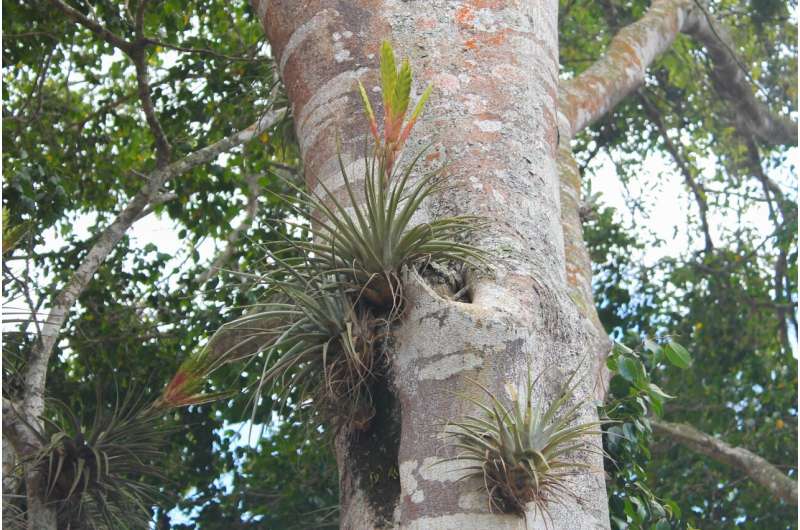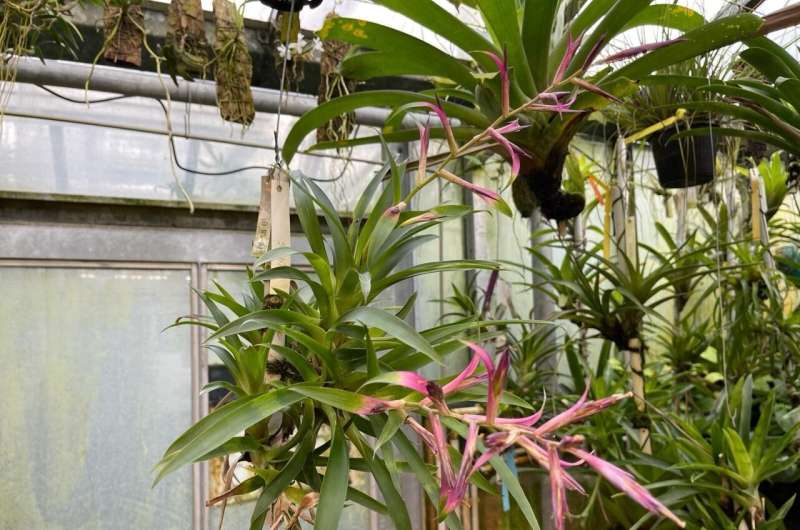This article has been reviewed according to Science X's editorial process and policies. Editors have highlighted the following attributes while ensuring the content's credibility:
fact-checked
peer-reviewed publication
trusted source
proofread
Adaptation of photosynthetic mechanism in air plants occurs through gene duplication, study finds

Researchers at the University of Vienna, along with collaborators from France, Germany, Switzerland and the U.S., have achieved a breakthrough in understanding how genetic drivers influence the evolution of a specific photosynthesis mechanism in Tillandsia (air plants). This sheds light on the complex actions that cause plant adaptation and ecological diversity. The results of their study are published in Plant Cell.
Some plant species have evolved a water-saving trait called Crassulacean Acid Metabolism (CAM). CAM plants like most Tillandsia species—the most species-rich genus in the pineapple family (Bromeliaceae)—optimize their water use efficiency: While other plants normally open their stomata (tiny pores in their leaves) during the day to absorb carbon dioxide for photosynthesis, CAM plants do this at night and stash CO2 away for later use, helping them survive with less water.
This trait evolved independently several times across the plant kingdom. However, the evolution of the complex genetic basis of CAM has remained elusive, making it a focus of research in evolutionary biology.
Gene regulation is key
In this study, the research team focused on a Tillandsia species pair exhibiting divergent forms of photosynthesis—CAM vs. C3—meaning that the C3-species lacks the specialized adaptation to arid conditions. By using advanced techniques to study the plants' genetics and biochemistry—e.g., analyses of gene arrangements, molecular and gene family evolution, temporal differential gene expression and metabolites—they discovered that changes in gene regulation are mainly responsible for genomic mechanisms driving CAM evolution in Tillandsia.
Clara Groot Crego, Department of Botany and Biodiversity Research at University of Vienna and lead author of the study, explains, "Our findings reveal that while large-scale changes have influenced Tillandsia's genomes like other plants, the adjustment of how photosynthesis works mainly happens through how genes are regulated—not by changing the sequences that code for proteins."
Key insights from the study include the identification of CAM-related gene families undergoing accelerated expansion in CAM species. This highlights the critical role of gene family evolution in generating novel variation that drives CAM evolution.

Into new niches by repeated evolution
"CAM repeatedly evolved in different Tillandsia species and has accelerated their ability to colonize new ecological niches, serving as a key driver of the rampant speciation observed within this group," says Ovidiu Paun, Department of Botany and Biodiversity Research at University of Vienna and principal investigator of the study.
"Our research highlights the potential importance of genetic innovation, beyond mere base pair changes, in driving ecological diversification," Paun adds.
Thibault Leroy, principal investigator from INRAE Toulouse, France, emphasizes that this study has implications beyond basic science. "Understanding how CAM evolved can help develop strategies to make crops more resilient to water shortages and cope with climate change."
The research will be extended across more species of this and other plant groups in the framework of a newly collaborative project.
More information: Clara Groot Crego et al, CAM evolution is associated with gene family expansion in an explosive bromeliad radiation, The Plant Cell (2024). DOI: 10.1093/plcell/koae130
Journal information: Plant Cell
Provided by University of Vienna




















